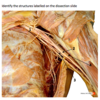MSK 2 - Upper Limbs Flashcards
a

Lesser tubercle
b

Coronoid fossa
c

Trochlea
d

Greater tubercle
e

Intertubercular groove
f

Deltoid tuberosity
g

Radial fossa
h

Capitulum
i

Surgical neck
j

Radial groove
k

Head
l

Anatomical neck
m

Shaft/diaphysis
n

Olecranon fossa
o

Medial epicondyle
what are muscle compartments?
An important concept when studying anatomy of the extremities is the arrangement of muscle groups within fascial compartments.
Fascial compartments contain groups of muscles and neurovascular structures enveloped by a layer of connective (fibrous) tissue.
Muscles in each compartment often (but not always) act similarly on a joint, sharing a common nerve and blood supply
what is in the Anterior Compartment of the Arm?
The anterior compartment contains 3 important muscles and their accompanying neurovascular supply. The muscles act on the elbow joint and superior radio-ulnar joint
1

Biceps brachii
2

Brachialis
3

Musculocutaneous nerve
4

Coracobrachialis
where is the biceps brachii located?
The biceps brachii is the most superficial muscle of the anterior compartment.
It arises from the scapula via. two heads. Both heads unite at the distal third of the upper arm forming a short tendon which inserts onto the radial tuberosity.
It also attaches through the bicipital aponeurosis to the deep fascia of the forearm
The muscle has a powerful action on the shoulder, elbow and radio-ulnar joints
The short head of the biceps muscle originates from the ________ process of the scapula
coracoid
The long head of the biceps muscle originates from the __________ tubercle of the scapula
Its tendon passes through the shoulder joint and runs down the _______ groove of the humerus
supraglenoid
bicipital
what is the function of the biceps brachii?
It flexes both the shoulder and elbow joint (action)
At the superior radio-ulnar joint it is involved in supination (the action in which the radius rotates over the ulna)
The coracobrachialis slender, rounded muscle passing from its origin at the tip of the _______ process and inserting to the ______ aspect of the mid-shaft of the humerus
coracoid
medial

what is the action of the coracobrachialis?
Its action is to flex the arm at the shoulder joint
The brachialis muscle arises from the _______ surface of the distal shaft of the humerus. It is a deep muscle of the anterior compartment, passing downwards and attaching to the _______ process of the ____
anterior
coronoid
ulna

what is the fucntion of the brachialis?
Its main action is to flex the elbow joint
where does the musculocutaneous nerve arise from?
This nerve arises as a terminal branch from the lateral cord of the brachial plexus
what is the function of the musculocutaneous nerve?
what is the location and route of the musculocutaneous nerve?
It enters the arm by perforating the coracobrachialis, descending distally between the biceps brachii and brachialis muscles. After crossing the elbow joint it gives off its terminal branch to supply the skin as the lateral cutaneous nerve of the forearm

What is the segmental or root value of the musculocutaneous nerve?
C 5 to C 7
Does the musculocutaneous nerve supply any muscles in the forearm or hand?
no
1

Axillary artery























